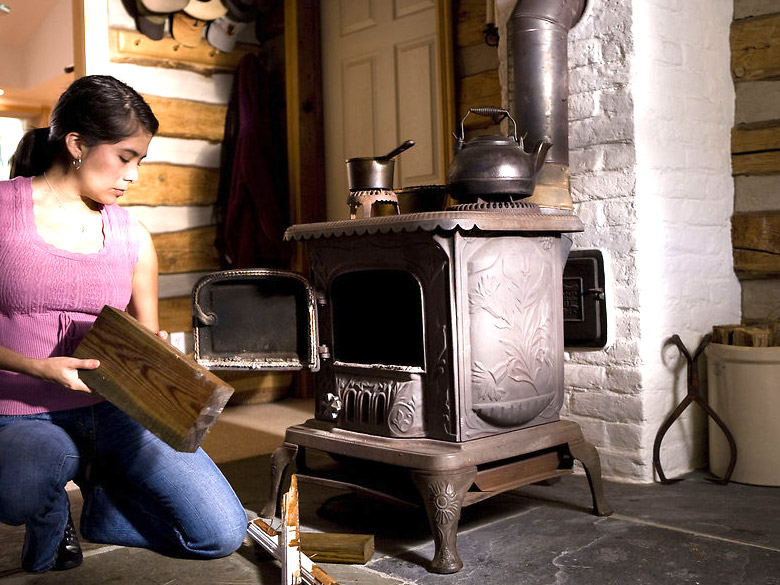Masonry Heating
A growing trend in the United States is the use of masonry heating. Masonry heaters have been in widespread use in Europe for many years, and as such, are also known as “Finnish fireplaces”, “Russian fireplaces” and “Siberian fireplaces”.
While masonry heaters are considered a stylish alternative to conventional woodstoves, their growing popularity can also be attributed to safety and efficiency considerations.
Masonry heaters and soapstone wood stoves are designed to store heat and release it slowly over extended periods of time. As a fire burns, the masonry absorbs the heat and slowly releases it throughout the day. The fire can be fuelled by wood, natural gas, propane or just about any other combustible material.
While a conventional woodstove may give off more intense heat, the heat dissipates quickly and the fire must be maintained with much more regularity. Because of the extremes of wood stove heating, it is difficult to find an acceptable balance. Many people find that wood stoves burn so hot that they can’t even stay in the same room and many people find they dry the air out as well. Another problem with a wood burning stove is the heat usually does not last through the night, leaving a cold home to wake up to in the morning.
Masonry heating systems come in a wide variety of sizes and styles. Smaller versions can be as small as a traditional wood burning stove, while more complex designs can cover entire walls. Many masonry heaters appear to be nothing more than a common fireplace, but the difference lies in the elaborate system of smoke channels. With a longer path to follow before being released in the open air, the design of these systems allows for more heat to be trapped in the brickwork for later release.
Masonry heaters are safer than other wood burning alternatives because the heat radiated from the unit is less intense and the fire requires less attention. There is less chance for accidental burns or fires from the cooler surface and less frequent opening of the hatch.
Masonry heaters are also much more efficient than conventional wood stoves and fireplaces. A masonry heating system can have as much as 90% combustion efficiency compared to just over 50% for common wood stoves and just 10% of a normal fireplace. Since less fuel is needed to provide the same amount of heat, a masonry heater naturally results in less air pollutants than the alternatives.
As an added efficiency, many masonry heating systems also feature a rear bake oven. Such a system could be designed to separate the dining room or living room from the kitchen, with the woodstove in front and the oven in back. As the fire burns, the brickwork radiates heat in all directions for warmth and the retained heat can also be utilized for cooking or boiling water in the oven.
Wood Stoves
The one disadvantage of masonry heating is the initial costs can be prohibitive. With the increasing popularity of these systems, there are prefabricated kits available, but many homes will require custom designs. Furthermore, in many cases existing infrastructure, such as the base or the chimney, will be inadequate and will require upgrades or even replacement. Any system will require extensive mason work, which is a technical trade beyond the skills of many homeowners for a do-it-yourself project.
Many people also feel that a masonry heating system is best suited for large homes. For smaller living spaces, a regular wood stove or a wood pellet stove may heat just as well, since the heat is contained in a smaller area, particularly if the home is well insulated.
Among wood burning appliances, wood stove inserts and wood pellet stoves are outpacing traditional stoves. Rather than typical chords of wood, wood pellet stoves burn compressed wood pellets that look much like rabbit food. These pellets are cheaper, burn longer and cleaner and are easier to handle, since they come in large bags.
Modern wood pellet stoves require little attention as some hoppers can hold over 100 pounds of pellets and the stove is self feeding based on a selected burn setting or in some cases a thermostat. This feature equates a wood pellet stove to the masonry heater in that the fire can safely burn through the night, providing a warm home in the morning.
Though not as efficient as a masonry heater, a wood pellet stove is much cleaner than traditional wood stoves. In fact, the pellets burn so cleanly, many wood pellet stoves do not require a chimney, but rather a small hole through the wall in behind the stove is sufficient to vent the exhaust.
The cost of a wood pellet stove is above a regular wood stove, but considerably less than a masonry heating system and a homeowner will often be able to handle the installation. For owners of small homes, a wood pellet stove is likely the most cost effective option.
Useful Links
Masonry Heater Association of North America – http://mha-net.org/
Pellet Fuels Institute – http://www.pelletheat.org
Woodheat.org – http://www.woodheat.org/

